Angle Information
An angle is the intersection of two rays with a common endpoint.
Remember that an angle is named using three letters, where the middle letter corresponds to the vertex of the angle. The angle at the right is ∠ABC or ∠CBA. If it is perfectly clear which angle is being named, an angle may be referred to by its vertex letter alone, such as ∠B.
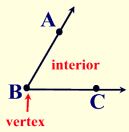
Angle Addition Postulate
If D lies in the interior of ∠ABC, then m∠ABD + m∠DBC = m∠ABC.

This concept is sometimes stated as “the whole is equal to the sum of its parts”.
Types of Angles (Definitions)
An acute angle is an angle whose measure is less than 90°

A right angle is an angle whose measure is 90°.

An obtuse angle is an angle whose measure is more than 90°, but less than 1800

A straight angle is an angle whose measure is 180°.

A reflex angle is an angle whose measure is more than 180°.

Pairs of Angles (Definitions)
The definitions above apply to angles when we look at one angle alone, but there are also some special relationships between pairs of angles.
Adjacent Angles are 2 angles that share a common vertex, a common side and no common interior points.
(They share a vertex and share a side, but do not overlap.)
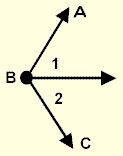
∠1 and ∠2 are adjacent angles.
∠1 and ∠ABC are NOT adjacent.
(∠ABC overlaps ∠1)
Vertical Angles are 2 angles whose sides form two pairs of opposite rays (straight lines). Vertical angles are not adjacent. They are located across from one another in the corners of the “X” formed by the two straight lines. They are always equal in measure.
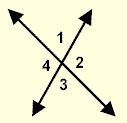
∠1 and ∠3 are vertical angles.
∠2 and ∠4 are vertical angles.
∠1 and ∠2 are NOT vertical.
THEOREM: Vertical angles are congruent.
Complementary Angles are 2 angles the sum of whose measures is 90°.
Complementary angles can be placed so that they form perpendicular lines, but do not “have to be” in this configuration.

∠1 and ∠2 are complementary.
∠XYZ and ∠1 are NOT complementary.
\(\overline { XY }\) ⊥\(\overline { YZ }\) (the rays are perpendicular)
THEOREM: Complements of the same angle, or congruent angles, are congruent.
Supplementary Angles are 2 angles the sum of whose measures is 180°. Supplementary angles can be placed so that they form a straight line (a linear pair), but they do not “have to be” in this configuration.
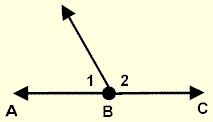
∠1 and ∠2 are supplementary.
The line passing through points A, B, and C is a straight line.
THEOREM: Supplements of the same angle, or congruent angles, are congruent.
A Linear Pair is 2 adjacent angles whose non-common sides form opposite rays. The angles MUST be adjacent.
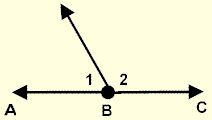
∠1 and ∠2 form a linear pair.
The line passing through points A, B, and C is a straight line.
∠1 and ∠2 are supplementary.
THEOREM: If two angles form a linear pair, they are supplementary.
THEOREM: If two congruent angles form a linear pair, they are right angles.